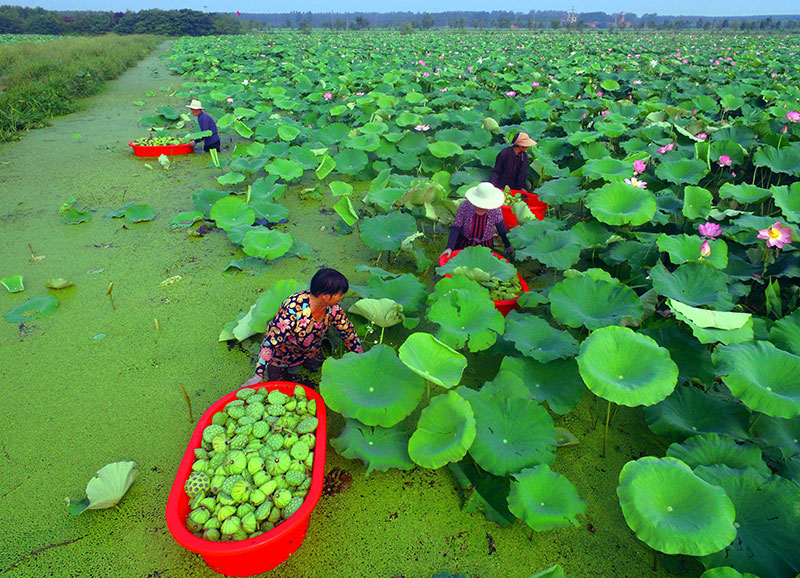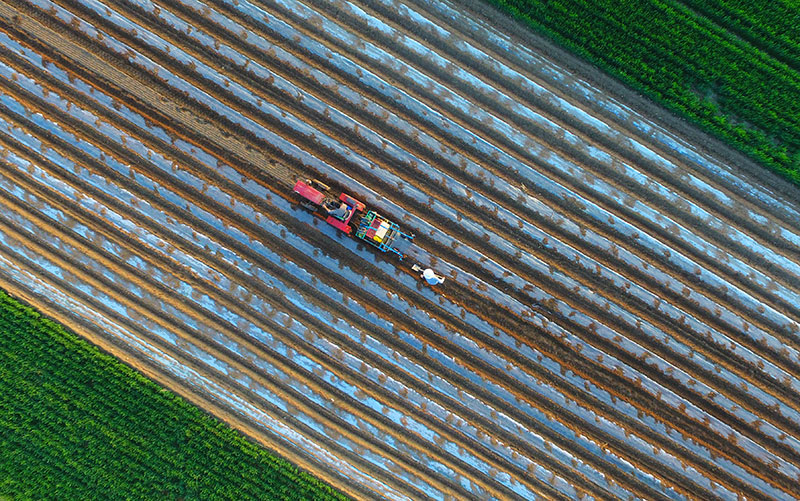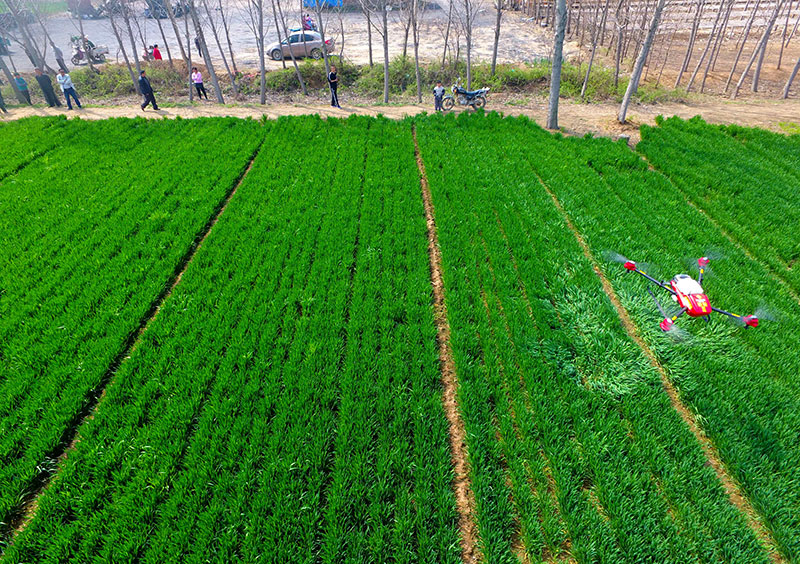The Importance of Being Able to Sweat
The North China Plain is a vast, fertile flood plain in the east of China around the lower Yellow River. Five times the size of Austria, it includes the capital Beijing and the city of Tianjin, China’s most important manufacturing city and the leading port of North China. The region has been described as the “heartland of modern China” and is one of the most densely populated parts of the planet. But a newly published scientific study suggests that if climate change continues unchecked, the North China Plain could become uninhabitable by the end of this century.

APA/AFP
This photo taken on August 1, 2018 shows people harvesting seed pods of lotus flowers from a pond in Tancheng in China’s eastern Shandong province.
The study was published by researchers at the Massachusetts Institute of Technology in the US and analyses not just the impact of climate change on extreme temperatures, but how heatwaves are made more dangerous through increased air humidity in the region. In combination, these two factors, when they reach certain levels, can be fatal. Joanna Bostock spoke to Dr David Santillo from the Greenpeace Research Laboratory at the University of Exeter in the UK:
Dieses Element ist nicht mehr verfügbar
FM4: This new research focusses on heat and humidity, can you explain why this is such a deadly combination?
David Santillo: Temperature extremes are already an issue for humans but one of the ways in which we cope is by sweating more. Unfortunately, when the humidity is high and there is a lot of moisture in the air at the same time as very high temperatures, those systems for sweating and natural temperature control of the body break down. There’s simply nowhere for the water to go and under those conditions the body’s core temperature can rise to very dangerous levels very quickly. That’s what can make these spaces almost uninhabitable for humans without air conditioning.

APA/AFP
This photo taken in April 2018 shows farmers planting peanuts in a field in Liaocheng in China’s eastern Shandong province.
FM4: So it’s not simply a case of those who are vulnerable, it’s everybody, even those who are fit and strong?
David Santillo: Absolutely. It may well be that more vulnerable people – very young people, very old people, people who aren’t so well – would be the first to suffer, as in any situation, but this is actually pushing humans to the limits of endurance simply because it exceeds those very fundamental biological limits. Our body processes rely on things staying in a fairly narrow temperature range and if we can’t sweat to lose that heat, even a very healthy person within a matter of hours can become very seriously ill.
FM4: In this particular case we’re talking about the North China Plain – where is the humidity coming from?
David Santillo: In this case the excess moisture is coming largely from the agricultural processes in the region, from the irrigation practices which are essential for growing the crops in that area. It’s naturally a very dry area so it relies on irrigation. This study is talking about one particular region where this seems to be a problem that is looking as if it will become particularly acute. It’s by no means the only part of the planet in which the combination of heatwaves and high humidity is set to become a problem. It is perhaps the first area, and it is also a very key area because it is very heavily populated – we’re talking about around four hundred million people – it’s one of the key areas for agriculture in China and if we get much more frequent heatwaves, more extreme temperatures this could be an area where we would see mass migration because it would just be uninhabitable.
FM4: Is there anything about the north China plain which makes it more susceptible to this phenomenon?
David Santillo: There are a number of reasons why this particular area has come out in this study as being one of the highest priorities. We’ve got to keep in mind that this is a modelling study, looking at projecting changes into the future, and there are always uncertainties associated with that. So this is in effect looking at probabilities. It’s not saying by any means that it’s the only region of the planet on which these concerns will likely come together, but looking at the combination of the fact that this is already an area which experiences these high temperature events, that it’s an area which – through its use of irrigation for very intensive agriculture – is already becoming a very humid area, and it’s a very populated area. Looking at all those things together it means that you’ve got the opportunity in that region for a very high proportion of the population to be experiencing increasingly in future years the kinds of conditions that will be very, very difficult for human beings to survive without having artificial cooling.
FM4: ... with all sorts of repercussions for the people, the food supply, the economy, for the cities where these people would try to relocate to ...
Suchul Kang & Elfatih A. B. Eltahir: North China Plain threatened by deadly heatwaves due to climate change and irrigation. Nature Communicationsvolume 9, Article number: 2894 (2018)
David Santillo: Huge knock on effects! If you’re affecting a huge area of population, an area on which large parts of the rest of China rely in terms of food production, and if you have a migration away from those areas, that will have huge social and economic impacts. It could have impacts on wildlife in that region as well; it could have impacts on wildlife in areas that then have to become centres of human population. So really, almost unimaginable consequences in the future, if the projections in this paper were to become a reality. But I think we do need to keep in mind that unless we get a grip on our emissions of greenhouse gases, unless we really start to make a change ... Of course, China is one of the biggest emitters of greenhouse gases, but we can’t blame this problem entirely on China. We’re all contributing to the conditions that will cause these problems on the North China Plain, and will cause similar problems in areas of India, in other tropical and sub-tropical regions around the planet. We’re all responsible for this. Unless we can actually bring our greenhouse gas emissions under control and really start to tackle climate change, we could well be putting the human race into a situation which we’ve not currently experienced: creating areas of the planet which we’ve been living in, relying on, and which will become uninhabitable.

AFP
An agricultural drone is used to spray pesticide on crops in a village in Chiping county, east China’s Shandong province (April 2017).
FM4: So if you’re saying there’s a need for action, does that mean that there is still hope that this could be prevented?
David Santillo: There is definitely hope that we can avoid the worst excesses of climate change. That would include the worst of the heat extremes that are being projected for the future and the worst situations where you get that combination of high heat and high humidity. But to avoid those problems occurring later in this century we’ve got to take action now, and unless we achieve really deep and urgent cuts in our greenhouse gas emissions, we’re storing up problems for our children, for our grandchildren. And I think we shouldn’t look at this as being just a theoretical study, there’s a lot of very robust science underneath this. Of course, projections are always looking into the future, there’s always a degree of uncertainty, but what this study is showing is what we have been warned about in the past by numerous other researchers. It takes it to the next level of analysis and shows in very real terms one of those key areas that could be affected earlier than others.
FM4: We’ve heard a lot about heatwaves, extreme temperatures ... this has a different feel to it, the idea that people would just keel over, dead, because it’s hot AND humid ... why haven’t we heard about this before?
David Santillo: The rise in average temperatures is very well known as a consequence of climate change, but I think what’s been a little bit more behind the scenes is this understanding of the combination of high temperature and humidity. This has always been known as a problem, I think what’s new is the fact that this may become a reality over large areas of the planet, affecting huge numbers of people. And I think, just as we’ve realised in the past with developing science, that we shouldn’t just be looking at one factor but a combination of factors. This is no different if we want to look at just what level of risk this presents to humans.
Publiziert am 03.08.2018




















